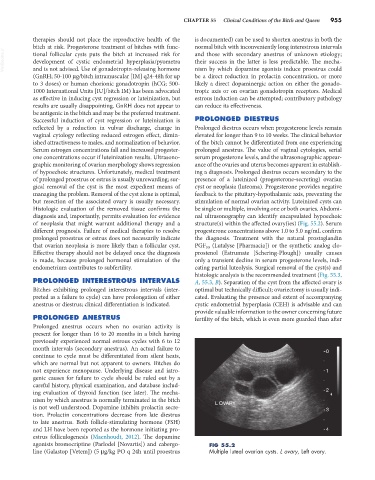Page 983 - Small Animal Internal Medicine, 6th Edition
P. 983
CHAPTER 55 Clinical Conditions of the Bitch and Queen 955
therapies should not place the reproductive health of the is documented) can be used to shorten anestrus in both the
bitch at risk. Progesterone treatment of bitches with func- normal bitch with inconveniently long interestrous intervals
VetBooks.ir tional follicular cysts puts the bitch at increased risk for and those with secondary anestrus of unknown etiology;
their success in the latter is less predictable. The mecha-
development of cystic endometrial hyperplasia/pyometra
and is not advised. Use of gonadotropin-releasing hormone
be a direct reduction in prolactin concentration, or more
(GnRH; 50-100 µg/bitch intramuscular [IM] q24-48h for up nism by which dopamine agonists induce proestrus could
to 3 doses) or human chorionic gonadotropin (hCG; 500- likely a direct dopaminergic action on either the gonado-
1000 International Units [IU]/bitch IM) has been advocated tropic axis or on ovarian gonadotropin receptors. Medical
as effective in inducing cyst regression or luteinization, but estrous induction can be attempted; contributory pathology
results are usually disappointing. GnRH does not appear to can reduce its effectiveness.
be antigenic in the bitch and may be the preferred treatment.
Successful induction of cyst regression or luteinization is PROLONGED DIESTRUS
reflected by a reduction in vulvar discharge, change in Prolonged diestrus occurs when progesterone levels remain
vaginal cytology reflecting reduced estrogen effect, dimin- elevated for longer than 9 to 10 weeks. The clinical behavior
ished attractiveness to males, and normalization of behavior. of the bitch cannot be differentiated from one experiencing
Serum estrogen concentrations fall and increased progester- prolonged anestrus. The value of vaginal cytologies, serial
one concentrations occur if luteinization results. Ultrasono- serum progesterone levels, and the ultrasonographic appear-
graphic monitoring of ovarian morphology shows regression ance of the ovaries and uterus becomes apparent in establish-
of hypoechoic structures. Unfortunately, medical treatment ing a diagnosis. Prolonged diestrus occurs secondary to the
of prolonged proestrus or estrus is usually unrewarding; sur- presence of a luteinized (progesterone-secreting) ovarian
gical removal of the cyst is the most expedient means of cyst or neoplasia (luteoma). Progesterone provides negative
managing the problem. Removal of the cyst alone is optimal, feedback to the pituitary-hypothalamic axis, preventing the
but resection of the associated ovary is usually necessary. stimulation of normal ovarian activity. Luteinized cysts can
Histologic evaluation of the removed tissue confirms the be single or multiple, involving one or both ovaries. Abdomi-
diagnosis and, importantly, permits evaluation for evidence nal ultrasonography can identify encapsulated hypoechoic
of neoplasia that might warrant additional therapy and a structure(s) within the affected ovary(ies) (Fig. 55.2). Serum
different prognosis. Failure of medical therapies to resolve progesterone concentrations above 1.0 to 5.0 ng/mL confirm
prolonged proestrus or estrus does not necessarily indicate the diagnosis. Treatment with the natural prostaglandin
that ovarian neoplasia is more likely than a follicular cyst. PGF 2α (Lutalyse [Pharmacia]) or the synthetic analog clo-
Effective therapy should not be delayed once the diagnosis prostenol (Estrumate [Schering-Plough]) usually causes
is made, because prolonged hormonal stimulation of the only a transient decline in serum progesterone levels, indi-
endometrium contributes to subfertility. cating partial luteolysis. Surgical removal of the cyst(s) and
histologic analysis is the recommended treatment (Fig. 55.3,
PROLONGED INTERESTROUS INTERVALS A, 55.3, B). Separation of the cyst from the affected ovary is
Bitches exhibiting prolonged interestrous intervals (inter- optimal but technically difficult; ovariectomy is usually indi-
preted as a failure to cycle) can have prolongation of either cated. Evaluating the presence and extent of accompanying
anestrus or diestrus; clinical differentiation is indicated. cystic endometrial hyperplasia (CEH) is advisable and can
provide valuable information to the owner concerning future
PROLONGED ANESTRUS fertility of the bitch, which is even more guarded than after
Prolonged anestrus occurs when no ovarian activity is
present for longer than 16 to 20 months in a bitch having
previously experienced normal estrous cycles with 6 to 12
month intervals (secondary anestrus). An actual failure to 0
continue to cycle must be differentiated from silent heats,
which are normal but not apparent to owners. Bitches do
not experience menopause. Underlying disease and iatro- 1
genic causes for failure to cycle should be ruled out by a
careful history, physical examination, and database includ-
ing evaluation of thyroid function (see later). The mecha- 2
nism by which anestrus is normally terminated in the bitch L OVARY
is not well understood. Dopamine inhibits prolactin secre- 3
tion. Prolactin concentrations decrease from late diestrus
to late anestrus. Both follicle-stimulating hormone (FSH)
and LH have been reported as the hormone initiating pro- 4
estrus folliculogenesis (Maenhoudt, 2012). The dopamine
agonists bromocriptine (Parlodel [Novartis]) and cabergo- FIG 55.2
line (Galastop [Vetem]) (5 µg/kg PO q 24h until proestrus Multiple luteal ovarian cysts. L ovary, Left ovary.

